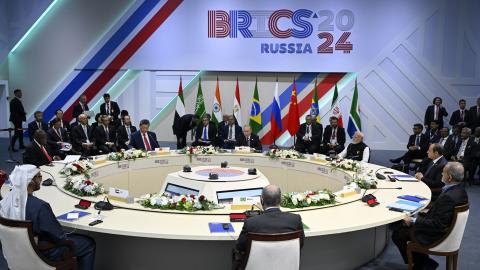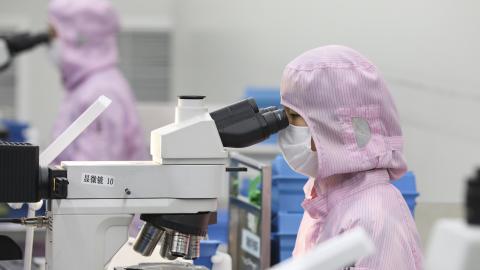Beijing's latest decision to cut the United States off from Chinese exports of various critical minerals reinforces the imperative of American reindustrialization. Over-reliance on any one country, but particularly a hostile geopolitical rival, for strategically important components is a threat to U.S. national and economic security.
Donald Trump’s reelection offers an opportunity to advance a reindustrialization strategy to boost American manufacturing and restore national sovereignty. A growing number of Americans are realizing the need for reindustrialization. Trump can take transformative action in his second term.
The United States still lacks the capacity to produce critical goods at scale over sustained periods of time. China controls inputs into key sectors – such as the minerals needed to make computer chips, bullets, armor, and more. Major defense contractors remain dependent upon China for thousands of parts. In addition, despite years of attention, the U.S. defense industrial base remains vulnerable, with acute shortages of air-defense missiles as demand surges from the Middle East, leaving the United States vulnerable in the Pacific.
Reindustrialization is not all about additional government spending. It is about incentivizing new supply and demand opportunities, and unleashing American capital and ingenuity.
The new administration should focus on six lines of action. These are the underlying conditions required to make the progress that Trump is driving toward.
Prioritizing Critical Sectors
First, policymakers need to make strategic, sector-specific choices. Solar panels are not a strategic necessity. The United States must focus on the “manufacturing trifecta” for critical components: chips, batteries, and rare earth magnets. These are the necessary building blocks for virtually all electronic systems, from consumer electronics to advanced military weapons systems. Without electronics, missiles will not be intercepted, soldiers will struggle to communicate, and precision weapons will be less precise.
Chips, which are the brains of all advanced industrial sectors and technological products, are a major vulnerability. The United States only produces about 12 percent of the world’s chips. The most advanced semiconductors are manufactured by foreign companies, primarily TSMC, which is the source of 90 percent of the globe’s leading-edge chips. And it’s not just leading-edge chips – the United States must also produce the larger chips necessary for many national security and energy projects.
Even more troubling, the entire life cycle of batteries, which store the energy that powers most advanced techno-industrial systems, is controlled by China. Most recently, China has used this dominance to freeze supplies to U.S.-based companies, such as drone producers like Skydio.
Rare-earth magnets are the spine, turning electricity into motion via actuators, motors, and generators. They are fundamental components in everything from F-35 fighter jets to drones, nuclear submarines to robotics. Today, China controls over 90 percent of the global market share of these inputs. In other words, the United States is dependent on China for its military readiness.
The Trump administration should focus its reindustrialization strategy on these sectors, as well as others that have a strategic impact on defense and economic well-being.
Reducing Regulations
Second, Trump should undertake a regulatory reset. Reports indicate that 40 percent of major manufacturing projects linked to the CHIPs Act and the IRA have been delayed due to permitting and compliance with environmental standards. TSMC experienced initial delays although now its first factory in Arizona is producing chips; operations in its second fab are projected to start in 2028, followed by production in its third fab by the end of the decade.
The new administration should seek national security waivers to clear these obstacles.
This is a pervasive problem. The National Association of Manufacturers reports that current federal regulations can cost small manufacturing firms an average of $50,000 per employee. It takes over a decade to open a new mine. The Trump administration will be in an excellent position to expedite permitting at local, state, and federal levels. Successes during his first administration – including the reversal of more than 100 unnecessary environmental rules – contributed to “net regulatory savings of nearly $1 billion over its term.” Restarting these regulatory rollbacks will create a level playing field for American manufacturers and strengthen America’s arsenal of democracy. An even more ambitious goal would be to set short but achievable timelines for permitting factories, pipelines, mines, or other critical projects.
Closing the Skills Gap
Third, the new administration should solve – not merely describe – the industrial workforce challenge. A decade ago, one manufacturing association noted that the biggest problem was the dearth of skilled workers who knew robotics and basic engineering. Another study has estimated that by 2033, 3.8 million new jobs will exist, but we might not have skilled workers for half of them. Workforce shortages have already had negative impacts on a range of U.S. military programs and have even contributed to delays on presidential aircraft. These shortages impact the U.S. ability to build new platforms and repair existing ones. In the case of just the Navy, 100,000 new employees must be hired by 2032 to fulfill its five submarine-per-year procurement goal.
The Trump administration has an opportunity to focus on what works. Large-scale, general federal “re-training” programs underperform, while sectoral-based training, linked to specific potential employers, works. The Trump Administration should make this type of training a priority - perhaps through job training tax credits – and build upon its previous National Council for the American Worker, created in 2018 to incentivize private sector companies to establish educational pipelines that feed into manufacturing jobs.
Good examples might be to enable programs modeled on successful apprenticeship efforts like those of Lockheed Martin, Electric Boat, and Newport News Shipbuilding (NNS). The Apprentice School at NNS offers tuition-free apprenticeships in 19 trades and optional advanced programs, with the opportunity to earn associate degrees. The program has graduated over 10,000 apprentices, and today, more than 80 percent of graduates have remained at NNS for at least 10 years. Electric Boat has created partnerships with high schools across Rhode Island to teach and train students in the core trades for submarine production. Lockheed Martin partnered with local colleges in Florida to create a direct bridge for college students to enter the workforce, created a Vocational Scholarship Program to train students in engineering, technology, and advanced manufacturing fields, and developed “skill development programs” to retain employees.
These types of partnerships demonstrate a viable path forward, but growing them depends on long-term investments and coordination between defense contractors, educational institutions, and government agencies.
Powering Manufacturing
It will be impossible to reindustrialize America without abundant energy, and there is a growing realization that the United States and other industrialized societies are running out of electricity.
Currently, the industrial sector accounts for roughly 35% of total U.S. energy consumption, and manufacturing consumes about 76% of total industrial energy consumption.
Energy demand is set to rise dramatically, with data centers driving unprecedented growth in electricity requirements. This data is required to train and power AI’s complex computation systems and thus is integrally linked to U.S. national and economic security. Existing data centers consume roughly 30 times more energy per square foot compared to other commercial counterparts. Some experts predict that future levels of AI usage will require almost one and a half times the level of power from data centers in less than six years by 2030. Currently, the approximate amount of energy needed to sustain the sector’s growth is doubling every 100 days.
One reason that the Federal Energy Regulatory Commission (FERC) rejected Amazon Web Services (AWS) request to supplement its energy requirements with nuclear energy was due to concerns about grid reliability and increased energy costs for consumers. Grid reliability – particularly the Transmission & Distribution (T&D) of energy – is a serious problem. FERC still blocked the effort even though the dissenting commissioner called the denial a “step backward” for electric reliability and national security as well as a move that risked “America's leadership in AI because reliable electricity is the lifeblood” of data centers.
Moreover, manufacturing plants will not look like they did in the past: they will combine automation and new technologies. To ensure that we remain ahead in advanced manufacturing — so that companies like Divergent Technologies can manufacture automotive frames in the morning and cruise missiles at night on the same production line — we need energy.
We will also need more energy to onshore additional semiconductor plants: as an example, Micron Technology’s planned semiconductor fabrication plants in upstate New York will consume more electricity than the state of Vermont and use as much electricity as one million New York homes.
The new Administration is well-positioned to avert America’s energy train wreck. Trump’s focus on energy diversification and deregulation can jump-start the energy renewal required to enable reindustrialization.
His team will likely take advantage of what all sources have to offer, including natural gas, petroleum, renewables, nuclear fission, and eventually fusion. For example, he might take advantage of opportunities to convert U.S. coal power sites into nuclear power plants. He will likely be more realistic than the Biden administration and halt many of its rules – especially the most recent spate which would have forced power plants to shut down unless they reduce emissions by capturing and storing carbon dioxide.
Capital Mobilization
A successful reindustrialization strategy also requires capital. But the good news is that the U.S. government itself does not have to spend billions of taxpayer dollars. One of many of America’s advantages is its liquid capital markets. By some accounts, there is some $56 trillion in U.S. capital markets. Investors are eager to put this capital to work. If the government creates the right incentives to shape the “playing field,” these private funds will drive reindustrialization.
The new administration can advance policies to make the government a more efficient and effective partner in building new manufacturing facilities.
Investment opportunities and projects must compete for capital on a risk-adjusted return basis. One way that the U.S. government can encourage manufacturing and infrastructure investments is through the use of offtake agreements: a commitment to buy the output of a project. This type of agreement can be a massive capital unlock for projects. With such an agreement the U.S. government lowers risk - which consequently will lower the required cost of capital for investors in, for example, a magnet plant. This also decreases the required rate of return, improving the project finances and enabling the government to obtain better pricing. In another example, the U.S. government might encourage a private investor to invest in a strategic port in a contested area providing offtake to the sponsor – putting a warehouse at the port or entering into a long-term fuel supply agreement for ships docking at the port. In this way, the U.S. government shares in some of the risks of building new or upgrading existing manufacturing facilities and infrastructure by agreeing to buy products and services associated with these facilities.
Another important aspect of the capital stack is providing low-cost capital loans that lend (not spend) taxpayer dollars. For example, last year the Department of Energy provided a $214 million loan commitment to a startup called Solugen to enable the company to build a chemical plant that turns corn sugar (dextrose) into chemicals that are critical ingredients for the production of concrete, industrial and wastewater treatments, and potentially energetic materials.
In the defense industrial base specifically, procurement problems are legendary and longstanding. The Trump team should not start from scratch. We know what needs to be fixed. Twenty years ago, the chairman of the House Armed Services Committee said that we needed to “winnow through accumulated regulations ‘line by line,’ and thin them out, simplify, and rationalize.” Assisted by technology, the incoming Trump team can produce a better system by actually implementing the best ideas. There are many. And it is well known that DoD often does not use all of the options that it already has to speed processes. This too has to change. For each rule, the administration should ask: Do these regulations attract capital, support innovation, reduce costs, and inject competition? For many of these regulations, the answer will be “no.”
Newer efforts at DoD – such as the Office of Strategic Capital (OSC) – aim to attract and scale private capital to support industrial and technology priorities for national security. The OSC investment approach is to support critical dual-use components with broad commercial applications, such as advanced materials, thereby strengthening the broader industrial base; finance investments using tools such as loans and loan guarantees to attract private capital and minimize the use of federal funds; and lend (not spend) by using credit-based financial tools, whereby capital is expected to be repaid at limited cost to the taxpayer. The OSC can be an example that could be used more broadly throughout government. Its financing products can provide an attractive cost of capital but also extend loan durations (up to 50 years by statute) that allow businesses in the industrial space maneuver room to build and grow.
Meanwhile, venture capital has shown up time and again for defense tech companies in recent years. This year set a new record with nearly $3 billion raised. But as a Wall Street Journal article reported, “venture-backed companies have consistently received around 1 percent of total DoD award spending annually going back through 2018.” DoD must become a better customer to these non-traditional firms that have demonstrated innovative and useful capabilities to the warfighter. Without a clear DoD commitment to spend, companies that have successfully developed and transitioned technology into prototype products and services are unlikely to survive.
Trade
Finally, trade policies will be an essential component of rebuilding American domestic manufacturing. Globalization in the presence of mercantilist nations has been a disaster for the U.S. industrial base and those who worked within it, leading to what many have described as the deindustrialization of America. Trump and Robert Lighthizer, the trade architect during his first term, have made clear that the accumulation of years and years of trade deficits led to the United States trading “ownership of its productive assets and economic future for short-term consumption.” The incoming Trump administration is likely to agree with the economist Oren Cass’s assumption that trade policies profoundly affect domestic manufacturing.
When competing against countries that subsidize key industries – as China does its battery, solar panel, magnet, and shipping sectors (among others) – there is no “free market” or “free trade.” Trade policy must level the playing field or protect vital industries. Reindustrialization will require either government cash outlays or tariffs to protect industries that are being undercut by Chinese dumping and/or overcapacity. Given the costs associated with cash outlays – as well as the problems associated with choosing which specific companies to subsidize – tariffs are a viable and less costly option.
The next administration should first identify the sectors that are so vital to the United States that it must retain a domestic manufacturing base. Tariffs should be used to create a protected market for U.S. manufacturers (though this should be a competitive market involving multiple U.S. firms) and used against states that engage in systematic abusive trade practices. Tariffs could be negotiated down in exchange for an end to those abuses. In reality, however, for countries like China, its entire political-economic system contradicts the principles of free trade.
The administration should insist in trade negotiations – even with friends – that persistent large trade deficits be eliminated. This could be done through trade deals based on strict reciprocity in tariffs, managed trade in certain sectors (for example, Europe committing to buy U.S. energy resources), or unilateral tariffs if needed.
As Trump crafts his trade policies, they will shift the previous dynamic that resulted in more investment, jobs, and innovation for U.S. trading partners and less for the United States. This would be an engine for reindustrialization.
In Sum
Reindustrialization is not a new concept; it harks back to Alexander Hamilton’s 1791 Report on Manufacturing, which emphasized the necessity of a secure domestic industrial base for national independence. As the first Secretary of the Treasury, he was especially concerned about the ability of the colonies to sustain their nascent independence if they could not produce needed materials. For Hamilton, a secure and reliable domestic industrial base was necessary for a nation’s security.
Today, the stakes are equally high.
A second Trump administration could redefine America’s industrial future by focusing on strategic sectors, regulatory reform, workforce development, energy reliability, capital mobilization, and trade. This comprehensive approach would not only bolster national security but also ensure long-term economic prosperity, restoring America’s position as a global manufacturing leader.


















